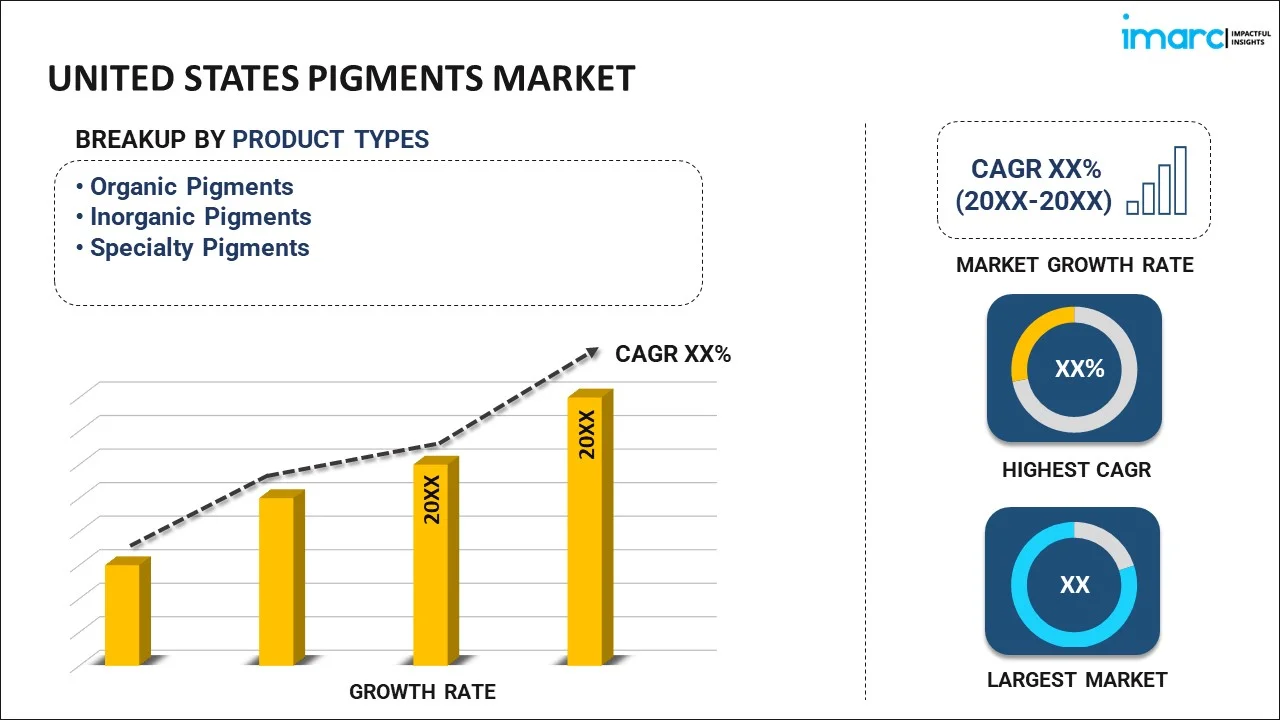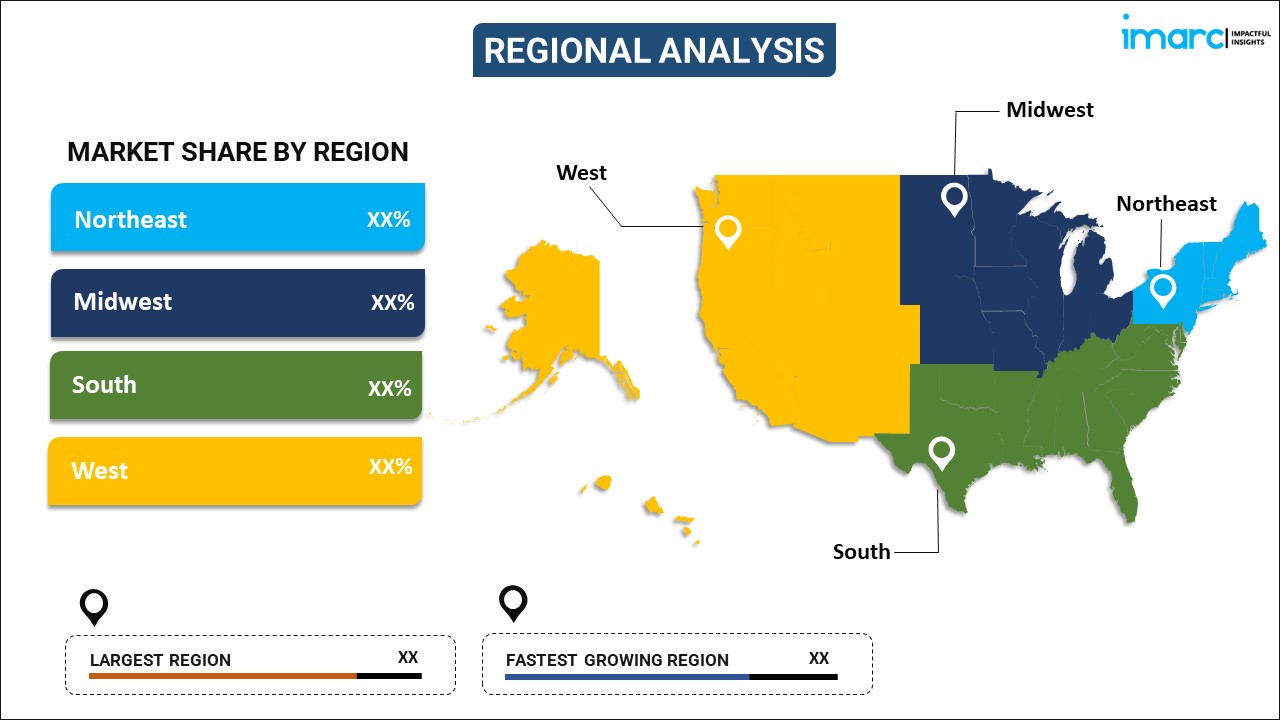
United States Pigments Market Report by Product Type (Organic Pigments, Inorganic Pigments, Specialty Pigments), Color Index (Red, Orange, Yellow, Blue, Green, Brown, and Others), Application (Paints and Coatings, Plastics, Printing Inks, Construction Materials, and Others), and Region 2025-2033
Market Overview:
United States pigments market size is projected to exhibit a growth rate (CAGR) of 3.99% during 2025-2033. The increasing demand for high-performance pigments that offer better durability, colorfastness, and other enhanced properties, is primarily driving the market.
|
Report Attribute
|
Key Statistics
|
|---|---|
|
Base Year
|
2024
|
|
Forecast Years
|
2025-2033
|
|
Historical Years
|
2019-2024
|
| Market Growth Rate 2025-2033 | 3.99% |
Pigments are colored substances that impart color to materials. In the context of art and design, pigments are finely ground, powdered particles that can be mixed with various mediums to create a wide range of hues. Derived from natural sources like minerals, plants, and animals, or synthetically produced, pigments play a crucial role in visual arts, providing artists with a diverse palette for expression. They are often incorporated into paints, inks, and dyes, allowing for the creation of vivid and lasting artworks. Pigments can exhibit unique properties, such as lightfastness and transparency, influencing the appearance and longevity of artistic creations. Additionally, advancements in technology have led to the development of specialized pigments for various industries, including textiles, cosmetics, and digital displays, showcasing the versatility and widespread application of these colorants.
United States Pigments Market Trends:
The pigments market in the United States is thriving, driven by a myriad of factors that collectively contribute to its robust growth. Firstly, the escalating demand for pigments can be attributed to the burgeoning automotive industry, where pigments find extensive use in automotive coatings. Additionally, the construction sector serves as a key driver, as pigments are integral to the production of vibrant and durable paints and coatings, enhancing the aesthetic appeal and longevity of structures. Furthermore, the rising popularity of eco-friendly and sustainable products propels the demand for organic pigments, reflecting an increasing awareness of environmental concerns. Moreover, the packaging industry plays a pivotal role in propelling the pigments market forward, with a surging need for vibrant and eye-catching packaging solutions. The textile industry also contributes significantly to the market's expansion, relying on pigments for dyeing fabrics and achieving a diverse range of colors. Furthermore, innovations in technology and research drive the development of advanced pigments, meeting the evolving demands of various industries. In conclusion, the pigments market in the United States is propelled by a confluence of factors spanning diverse sectors, showcasing its versatility and indispensability in today's dynamic industrial landscape.
United States Pigments Market Segmentation:
IMARC Group provides an analysis of the key trends in each segment of the market, along with forecasts at the country level for 2025-2033. Our report has categorized the market based on product type, color index, and application.
Product Type Insights:

- Organic Pigments
- Azo Pigments
- Phthalocyanine Pigment
- Quinacridone Pigment
- Others
- Inorganic Pigments
- Titanium Dioxide Pigments
- Iron Oxide Pigments
- Cadmium Pigments
- Carbon Black Pigments
- Chromium Oxide Pigments
- Complex Inorganic Pigments
- Others
- Specialty Pigments
- Classic Organic Pigments
- Metallic Pigments
- High-Performance Pigments
- Light Interference Pigments
- Fluorescent Pigment
- Luminescent Pigments
- Thermo-Chromic Pigments
The report has provided a detailed breakup and analysis of the market based on the product type. This includes organic pigments (azo pigments, phthalocyanine pigment, quinacridone pigment, and others), inorganic pigments (titanium dioxide pigments, iron oxide pigments, cadmium pigments, carbon black pigments, chromium oxide pigments, complex inorganic pigments, and others), and specialty pigments (classic organic pigments, metallic pigments, high-performance pigments, light interference pigments, fluorescent pigment, luminescent pigments, and thermo-chromic pigments).
Color Index Insights:
- Red
- Orange
- Yellow
- Blue
- Green
- Brown
- Others
A detailed breakup and analysis of the market based on the color index have also been provided in the report. This includes red, orange, yellow, blue, green, brown, and others.
Application Insights:
- Paints and Coatings
- Plastics
- Printing Inks
- Construction Materials
- Others
The report has provided a detailed breakup and analysis of the market based on the application. This includes paints and coatings, plastics, printing inks, construction materials, and others.
Regional Insights:

- Northeast
- Midwest
- South
- West
The report has also provided a comprehensive analysis of all the major regional markets, which include Northeast, Midwest, South, and West.
Competitive Landscape:
The market research report has also provided a comprehensive analysis of the competitive landscape. Competitive analysis such as market structure, key player positioning, top winning strategies, competitive dashboard, and company evaluation quadrant has been covered in the report. Also, detailed profiles of all major companies have been provided.
United States Pigments Market Report Coverage:
| Report Features | Details |
|---|---|
| Base Year of the Analysis | 2024 |
| Historical Period | 2019-2024 |
| Forecast Period | 2025-2033 |
| Units | Billion USD |
| Scope of the Report | Exploration of Historical Trends and Market Outlook, Industry Catalysts and Challenges, Segment-Wise Historical and Future Market Assessment:
|
| Product Types Covered |
|
| Colors Index Covered | Red, Orange, Yellow, Blue, Green, Brown, Others |
| Applications Covered | Paints and Coatings, Plastics, Printing Inks, Construction Materials, Others |
| Regions Covered | Northeast, Midwest, South, West |
| Customization Scope | 10% Free Customization |
| Post-Sale Analyst Support | 10-12 Weeks |
| Delivery Format | PDF and Excel through Email (We can also provide the editable version of the report in PPT/Word format on special request) |
Key Questions Answered in This Report:
- How has the United States pigments market performed so far and how will it perform in the coming years?
- What has been the impact of COVID-19 on the United States pigments market?
- What is the breakup of the United States pigments market on the basis of product type?
- What is the breakup of the United States pigments market on the basis of color index?
- What is the breakup of the United States pigments market on the basis of application?
- What are the various stages in the value chain of the United States pigments market?
- What are the key driving factors and challenges in the United States pigments?
- What is the structure of the United States pigments market and who are the key players?
- What is the degree of competition in the United States pigments market?
Key Benefits for Stakeholders:
- IMARC’s industry report offers a comprehensive quantitative analysis of various market segments, historical and current market trends, market forecasts, and dynamics of the United States pigments market from 2019-2033.
- The research report provides the latest information on the market drivers, challenges, and opportunities in the United States pigments market.
- Porter's five forces analysis assist stakeholders in assessing the impact of new entrants, competitive rivalry, supplier power, buyer power, and the threat of substitution. It helps stakeholders to analyze the level of competition within the United States pigments industry and its attractiveness.
- Competitive landscape allows stakeholders to understand their competitive environment and provides an insight into the current positions of key players in the market.
Need more help?
- Speak to our experienced analysts for insights on the current market scenarios.
- Include additional segments and countries to customize the report as per your requirement.
- Gain an unparalleled competitive advantage in your domain by understanding how to utilize the report and positively impacting your operations and revenue.
- For further assistance, please connect with our analysts.
 Inquire Before Buying
Inquire Before Buying
 Speak to an Analyst
Speak to an Analyst
 Request Brochure
Request Brochure
 Request Customization
Request Customization




.webp)




.webp)












